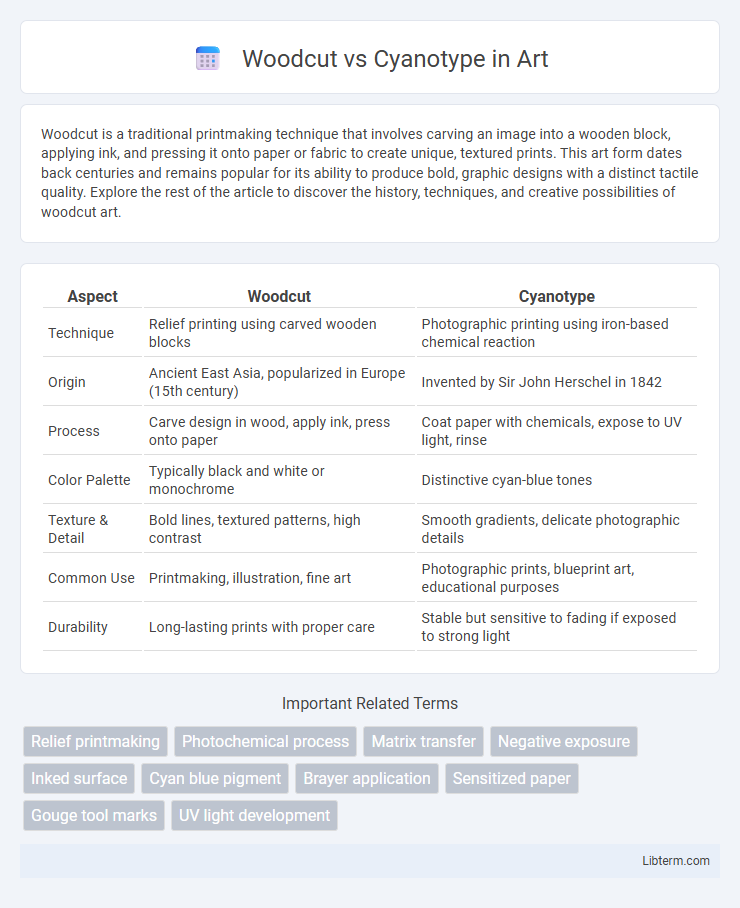Woodcut is a traditional printmaking technique that involves carving an image into a wooden block, applying ink, and pressing it onto paper or fabric to create unique, textured prints. This art form dates back centuries and remains popular for its ability to produce bold, graphic designs with a distinct tactile quality. Explore the rest of the article to discover the history, techniques, and creative possibilities of woodcut art.
Table of Comparison
| Aspect | Woodcut | Cyanotype |
|---|---|---|
| Technique | Relief printing using carved wooden blocks | Photographic printing using iron-based chemical reaction |
| Origin | Ancient East Asia, popularized in Europe (15th century) | Invented by Sir John Herschel in 1842 |
| Process | Carve design in wood, apply ink, press onto paper | Coat paper with chemicals, expose to UV light, rinse |
| Color Palette | Typically black and white or monochrome | Distinctive cyan-blue tones |
| Texture & Detail | Bold lines, textured patterns, high contrast | Smooth gradients, delicate photographic details |
| Common Use | Printmaking, illustration, fine art | Photographic prints, blueprint art, educational purposes |
| Durability | Long-lasting prints with proper care | Stable but sensitive to fading if exposed to strong light |
Introduction to Woodcut and Cyanotype
Woodcut is a traditional relief printing technique involving carving an image into a wooden block, which is then inked and pressed onto paper to create bold, textured prints. Cyanotype is a photographic printing process that uses a light-sensitive chemical solution to produce distinctive blue-toned images through exposure to UV light. Both methods offer unique artistic effects, with woodcut emphasizing tactile detail and cyanotype showcasing ethereal, high-contrast visuals.
Historical Origins and Evolution
Woodcut printing originated in ancient China during the Tang Dynasty (618-907 AD) as one of the earliest methods of relief printing, evolving through Europe in the Middle Ages to dominate book illustration and fine art by the Renaissance. Cyanotype, invented in 1842 by Sir John Herschel, emerged as a photographic printing process utilizing iron salts to create distinctive blue prints, initially popularized for botanical documentation and engineering blueprints. Both techniques reflect distinct technological advancements: woodcut's manual carving and inking of wooden blocks contrast with cyanotype's chemical exposure and washing, marking significant shifts in artistic reproduction and scientific imaging.
Materials and Tools Required
Woodcut printmaking requires materials such as a wooden block, carving tools like gouges and chisels, ink, and paper specifically suited for relief printing. In contrast, cyanotype involves photosensitive chemicals including ferric ammonium citrate and potassium ferricyanide, UV light exposure sources, and substrates like watercolor paper or cotton fabric. While woodcut emphasizes physical carving tools and manual ink application, cyanotype relies on chemical preparation and light exposure to create images.
Process Overview: Woodcut Technique
The woodcut technique involves carving an image into the surface of a wooden block, leaving raised areas that will receive ink while recessed areas remain ink-free. Ink is applied to the raised surfaces using a roller or brayer, and the block is then pressed onto paper or fabric to transfer the image. This relief printing method requires precision in carving and inking to achieve detailed, high-contrast prints characteristic of woodcut art.
Process Overview: Cyanotype Technique
The cyanotype technique involves coating paper or fabric with a photosensitive solution made from ferric ammonium citrate and potassium ferricyanide. Once dried, the material is exposed to UV light with objects or negatives placed on top, creating a design through a chemical reaction that turns exposed areas blue. After exposure, the print is rinsed in water to wash away unexposed chemicals, revealing a vivid Prussian blue image known for its distinct tonal quality.
Visual Qualities and Aesthetic Differences
Woodcut prints exhibit bold, textured lines with strong contrasts and a tactile, handcrafted feel, emphasizing sharp edges and rich black-and-white interplay. Cyanotype images showcase ethereal blue tones and soft gradients, creating a dreamy, photographic quality with smooth transitions and delicate detail. The stark graphic intensity of woodcuts contrasts distinctly with the gentle, atmospheric mood characteristic of cyanotypes.
Artistic Applications and Styles
Woodcut prints showcase bold, textured lines ideal for expressive, graphic compositions, often emphasizing strong contrasts and intricate details. Cyanotype offers a unique, ethereal blue-toned aesthetic, popular for botanical studies and experimental photographic techniques involving textured surfaces and shadows. Artists leverage woodcut for traditional, tactile craftsmanship while using cyanotype to explore light-sensitive processes and soft, atmospheric effects.
Durability and Preservation
Woodcut prints, created using carved wooden blocks and oil-based or water-based inks, exhibit high durability due to the robust materials and traditional printing methods, allowing them to withstand handling and environmental exposure over centuries. Cyanotypes, produced through a light-sensitive chemical process using ferric ammonium citrate and potassium ferricyanide, are more prone to fading and deterioration when exposed to prolonged sunlight and humidity, requiring careful preservation under controlled conditions. The archival longevity of woodcuts generally surpasses that of cyanotypes, making woodcut prints preferable for long-term display and collection.
Contemporary Uses and Innovations
Woodcut printing, traditionally rooted in relief techniques, has seen a resurgence in contemporary art through the integration of digital carving technologies and experimental materials, enabling more intricate and large-scale designs. Cyanotype, known for its distinctive Prussian blue tones, has evolved beyond simple botanical prints to incorporate mixed media and digital negatives, expanding its artistic and commercial applications such as textile design and alternative photography processes. Both methods are embraced by modern artists for their unique textures and eco-friendly processes, driving innovations in sustainable art production and cross-disciplinary collaborations.
Choosing Between Woodcut and Cyanotype
Choosing between woodcut and cyanotype depends on the desired artistic effect and technical approach; woodcut offers bold, textured prints with rich contrast through carved relief printing, while cyanotype produces ethereal, blue-toned images using a photographic process. Woodcut excels in graphic, tactile artwork suitable for limited color palettes, whereas cyanotype suits detailed, delicate imagery emphasizing light and shadow. Artists should consider the print's visual style, production complexity, and material requirements when selecting the appropriate medium.
Woodcut Infographic

 libterm.com
libterm.com